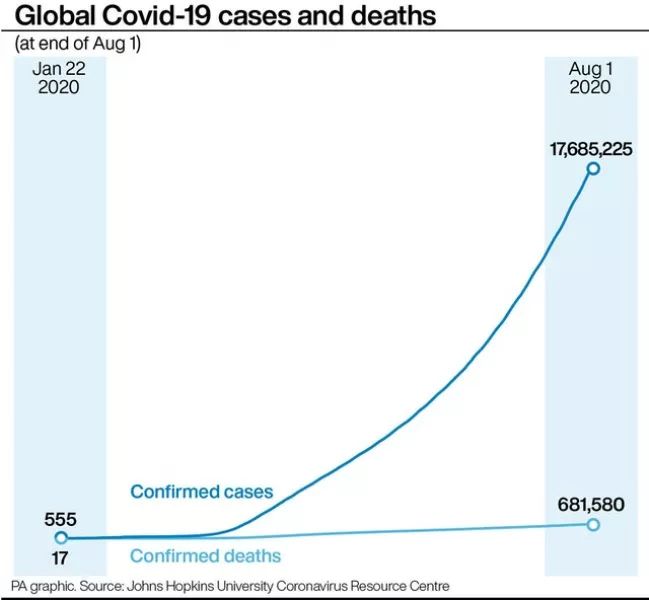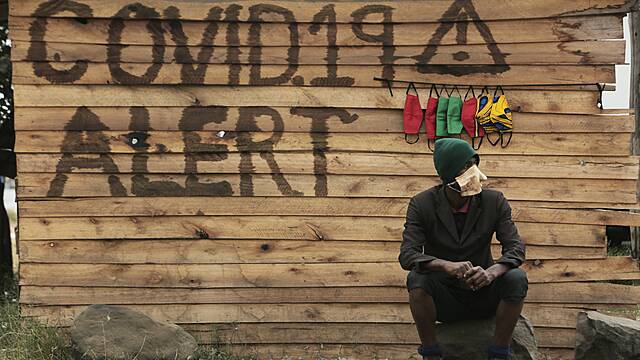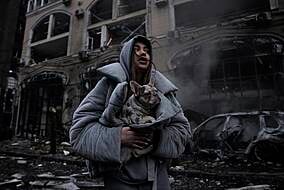A curfew was imposed on Australia’s second-largest city, Melbourne, following a rise in infections.
The United States, India and South Africa are struggling to rein in their first wave of infections, while South Korea and other countries where the disease abated try to avert a second wave as curbs on travel and trade ease.

India’s 54,735 new cases were down from the previous day’s record 57,118, but raised the country’s total to 1.75 million. July accounted for more than 1.1 million of those cases.
The major cities of New Delhi and Mumbai might have passed their peaks, said a government expert, Randeep Guleria. Cinemas and other public facilities are closed until August 31.
The Philippines reported 5,032 new cases, raising its total to 103,185, with 2,059 deaths.
On Saturday, leaders of medical organisations appealed to President Rodrigo Duterte to reimpose a lockdown on the capital Manila, warning the health system is in danger as personnel fall ill or quit due to fear or fatigue.
In Japan, the government said all but five of its 1,540 new cases were transmitted domestically. The daily total was close to Friday’s record of 1,579.
The rise in Japanese cases, most of them people in their 20s and 30s, prompted warnings that young people were letting their guard down.
Governor Yuriko Koike of Tokyo, which has about one-third of the new infections, says she might declare an emergency to contain the outbreak.
In Florida, authorities were trying to prepare storm shelters while enforcing social distancing, as Tropical Storm Isaias churned towards the heavily populated state. It was due to be near the coast early Sunday.

Florida reported 179 deaths on Saturday, raising its total to more than 7,000.
In Australia, Premier Daniel Andrews of the southern state of Victoria announced an 8pm to 5am curfew on Melbourne, a city of five million people. Schools statewide are to return to home-based teaching and day care centres were closed.
Mr Andrews said there were seven deaths and 671 new cases since Saturday. “If we don’t make these changes, we’re not going to get through this,” he added.
Also on Sunday, China and South Korea reported more infections but spikes in both countries appeared to be tailing off.
China had 49 new confirmed cases, up from the previous day’s 45. Thirty were in Xinjiang in the northwest, where authorities are trying to contain an outbreak focused on the regional capital, Urumqi.
Three cases were found in students who returned from Russia to Wuhan, the southern city where the pandemic began in December.

Most anti-disease controls were lifted there after the ruling Communist Party declared victory over the disease in March.
Hong Kong reported 125 new infections as authorities tried to find the source of its latest outbreak. The Chinese government said a team of seven virus testing experts was sent to the city to help.
South Korea reported 30 new cases, raising its total to 14,366 with 301 deaths, but said only eight were acquired in the country.
The government warned earlier case numbers would rise as South Koreans came home from the Middle East and other places with outbreaks. Authorities say cases from abroad are less threatening because arrivals are quarantined for two weeks.
On Saturday, the leader of a secretive Korean church was arrested in an investigation into whether the group hampered the anti-virus response after thousands of worshippers were infected in February and March.
Governments worldwide have reported 684,075 deaths and 17.8 million cases, according to data gathered by Johns Hopkins University.
The United States has the world’s biggest number of cases at 4.6 million, or one-quarter of the total, and 154,361 deaths.
On Saturday, South Africa reported 10,107 new cases, raising its total to 503,290.
That put the country fifth behind the United States, Brazil, Russia and India in total cases, though its population of 58 million is much smaller than theirs.
In Europe, the number of new cases reported in Italy dipped below 300 for the first time.







